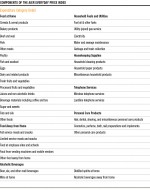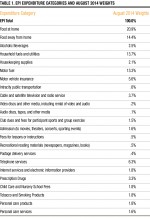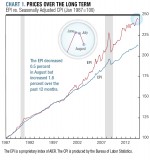Higher Food Prices Offset by Lower Energy Prices
The August declines in the EPI and the CPI represent slight changes from the July numbers, when both indexes were unchanged from the month before. Despite the August decreases, over the past 12 months the EPI increased 1.8 percent while the CPI increased 1.7 percent. The year-over-year changes in both the EPI and CPI reflect the slowest growth in prices since March. Both the EPI and CPI indicate that inflation remains tame around 2 percent.
Higher food prices in August were evident at the grocery store and in restaurants. Food at home prices increased 0.4 percent, while food away from home increased 0.2 percent.
Food at home prices were led higher by a 1.9 percent increase in meats, poultry, fish, and eggs. Meat prices increased 2.8 percent with a 4.2 percent increase in beef and veal. A 3.4 percent increase in ground beef pinched consumer budgets. Pork prices increased 2.1 percent, with a 4.2 percent increase in pork chops. Whole chicken increased 3.3 percent but turkey decreased 1.0 percent. Seafood prices were unchanged but eggs increased 0.8 percent and butter increased 2.4 percent.
Offsetting higher meat prices, fresh and frozen fruits and vegetables decreased 0.9 percent and 2.4 percent respectively.
Even though the summer driving season was in full swing in August, motor fuel prices decreased 4.1 percent. There was relief at the pump across fuel grades, regular decreased 4.2 percent, mid-grade decreased 3.8 percent, premium decreased 3.8 percent, and diesel decreased 1.5 percent. Public transit riders found that prices decreased 0.1 percent. Opening your utility bill was a welcome surprise, electricity decreased 0.4 percent and gas service decreased 3.0 percent. In fact the only energy prices that increased in August were propane and firewood, squeezing end of summer fun and Labor Day. Other price changes included a 0.7 percent decrease in cable service and a 0.1 percent decrease in internet services. Phone services, however, were flat.
Looking back over the past 12 months, food at home prices increased 2.9 percent and food away from home prices increased 2.5 percent while energy prices were mixed. Motor fuel decreased 2.7 percent, but utilities increased 5.8 percent. Year-over-year ground beef increased 12.8 percent, roasts increased 19.0 percent, steaks increased 15.6 percent, and pork chops increased 13.7 percent. Other price changes in grocery cart staples included a 9.7 percent increase in eggs, a 5.9 percent increase in milk, a 18.8 percent increase in butter, and a 6.5 percent increase in citrus fruits.
About the EPI
AIER’s Everyday Price Index (EPI) measures the changing prices of frequently purchased items like food and utilities. We do this by selecting the prices of goods and services from the thousands collected monthly by the Bureau of Labor Statistics in computing its Consumer Price Index. The EPI basket contains only prices of goods and services that Americans typically buy at least once a month, excluding contractually fixed purchases such as mortgages. Our staff economists weight each EPI category in proportion to its share of Americans’ average monthly expenditures. In order to better reflect the out-of-pocket prices that consumers experience on a daily basis, the EPI does not seasonally adjust prices.
To learn more about our methodology, view the weights assigned to each component, and browse past EPI updates, visit AIER’s EPI Methodology page.







